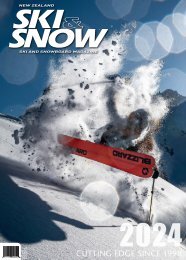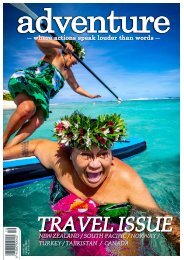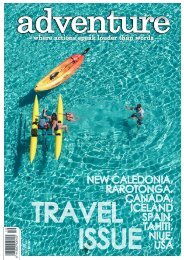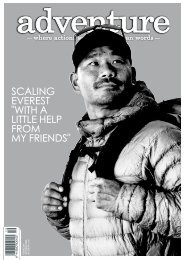ADV229 online
Summer issue of Adventure Magazine
Summer issue of Adventure Magazine
Create successful ePaper yourself
Turn your PDF publications into a flip-book with our unique Google optimized e-Paper software.
LONGBOARDING<br />
the classic art<br />
the concept of surfing across the face<br />
of the wave on a smaller board (still at<br />
least 9-10 ft). Copeland and Stoner also<br />
helped locals to make copies of their<br />
boards, introducing modern surfing and<br />
surfboards to New Zealand. These new<br />
surfing techniques put more emphasis<br />
on the surf conditions, causing surfers<br />
to go in search of better locations and<br />
conditions to hunt for breaking waves<br />
that peeled off rather than crashed<br />
straight to the beach. Basically, this was<br />
the birth of surfing, but it was all still<br />
longboarding<br />
Sure the shortboard era came and<br />
stayed, but in the background,<br />
Longboarding still managed to tick<br />
along. There came a full resurgence in<br />
early 1990 as surfers saw the value and<br />
appeal of the longboard.<br />
The art of Longboarding is timeless, it is<br />
an art. They say that longboard surfing<br />
is a state of mind. An idealized stage of<br />
mindfulness.<br />
In the 1960’s surfing arrived in New<br />
Zealand not surfing as we know it but<br />
Longboarding. A few clubies were playing<br />
with hollow surf skis but not until 1959<br />
did two Americans come in New Zealand<br />
and kicked alive a revolution and a<br />
culture.<br />
However, surfing has always been a part<br />
of Māori culture, the practice was called<br />
whakahekeheke. It was carried out using<br />
a variety of craft, including boards, or<br />
kopapa, and even bags of kelp, but the<br />
Christian missionary ‘killjoys’ put a quick<br />
stop to that.<br />
Surfing came back into focus following<br />
a tour of New Zealand by the Hawai'ian<br />
surfer Duke Kahanamoku in 1915 at Lyall<br />
Bay Surf Life Saving Club, in Wellington.<br />
Where he gave demonstrations to locals<br />
on how to surf and by the 1920s and<br />
1930s, New Zealanders were surfing<br />
using solid wooden boards or hollow<br />
ones mainly for surf lifesaving.<br />
Surfing was utilized in the Surf Lifesaving<br />
movement, which used heavy hollow<br />
longboards to paddle through the surf<br />
and rescue people.<br />
Up until this point, surfing consisted<br />
of riding the wave in a straight line<br />
directly to the beach. In 1958, two<br />
American lifeguards, Bing Copeland<br />
and Rick Stoner, came to stay at Piha<br />
Surf Lifesaving Club and introduced<br />
There are more longboarders in the<br />
world than you might think. Some of them<br />
are not full-time ‘loggers’; they own a<br />
respectable ‘quiver’ of boards, and when<br />
the surf is smaller, and other surfers are<br />
sitting on the beach the longboarders can<br />
enjoy the smaller waves as much as, the<br />
more powerful ones.<br />
The 1990s kicked off the nostalgia<br />
period, and the classic longboard<br />
shapers started getting back to the old<br />
designs. Shapers like Roger Hall from<br />
Surfline in Ruakaka who had never left<br />
his roots in Longboarding began a new<br />
era in longboarding New Zealand and<br />
started to come up with some innovation.<br />
Currently, he is designing board with a<br />
wing keel that does not require a fin!<br />
.<br />
There is less rip and tear on a longboard<br />
than a shortboard, but there is still a<br />
range of moves to be made and refine.<br />
Nose riding, tip riding, helicopters,<br />
88//WHERE ACTIONS SPEAK LOUDER THAN WORDS/#229

















